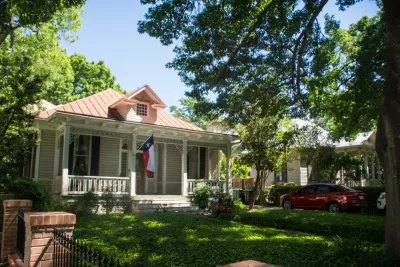As the city considers loosening regulations on accessory dwelling units, one writer argues that the reforms would boost affordable housing and provide more options for changing household needs.

A San Antonio Report piece by Jim Bailey argues in favor of reforming the city’s regulations governing accessory dwelling units (ADUs) to make it easier for homeowners to build ‘granny flats’ and meet the changing needs of families. As Bailey states, “Currently, our city’s development code allows homeowners to build ADUs, but outdated restrictions make it difficult for owners to build them. Removing these barriers should be part of a larger strategy that looks at how San Antonio can grow responsibly.”
According to Bailey, “San Antonio added more residents than any other city in the country last year, and is projected to add a million more by 2050.” Bailey offers one possible solution. “One simple thing we can do to build resilience in neighborhoods like we used to have is to make it easier to build modest accessory dwelling units.” Bailey highlights the benefits of ADUs: the ability for multigenerational families to live together while maintaining privacy and autonomy, an opportunity for renters to live affordably in neighborhoods previously inaccessible to them, a source of income for homeowners, and an affordable option for seniors who want to “age in place” in their neighborhoods.
In San Antonio, Bailey writes, “Our Removing Barriers to Affordable Housing Development & Preservation Subcommittee, as instructed by our Council-adopted Strategic Housing Implementation Plan, has been working on a series of code changes that make sensitive insertions of modest ADUs into neighborhoods a little easier to achieve.” These include reduced restrictions on ADU occupancy, uniform height limits, and a clear metric for allowable square footage.
While Bailey and housing advocates recognize that boosting ADU construction is by no means a silver bullet for solving the housing crisis, “the proposed amendments help ameliorate growing housing pressures” in a fast-growing city.
FULL STORY: Removing barriers to building accessory dwelling units is the right move for San Antonio

National Parks Layoffs Will Cause Communities to Lose Billions
Thousands of essential park workers were laid off this week, just before the busy spring break season.

Retro-silient?: America’s First “Eco-burb,” The Woodlands Turns 50
A master-planned community north of Houston offers lessons on green infrastructure and resilient design, but falls short of its founder’s lofty affordability and walkability goals.

Delivering for America Plan Will Downgrade Mail Service in at Least 49.5 Percent of Zip Codes
Republican and Democrat lawmakers criticize the plan for its disproportionate negative impact on rural communities.

Test News Post 1
This is a summary

Test News Headline 46
Test for the image on the front page.

Balancing Bombs and Butterflies: How the National Guard Protects a Rare Species
The National Guard at Fort Indiantown Gap uses GIS technology and land management strategies to balance military training with conservation efforts, ensuring the survival of the rare eastern regal fritillary butterfly.
Urban Design for Planners 1: Software Tools
This six-course series explores essential urban design concepts using open source software and equips planners with the tools they need to participate fully in the urban design process.
Planning for Universal Design
Learn the tools for implementing Universal Design in planning regulations.
EMC Planning Group, Inc.
Planetizen
Planetizen
Mpact (formerly Rail~Volution)
Great Falls Development Authority, Inc.
HUDs Office of Policy Development and Research
NYU Wagner Graduate School of Public Service





























